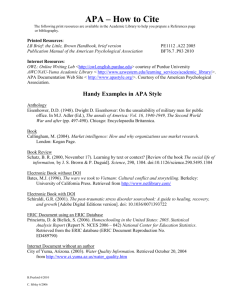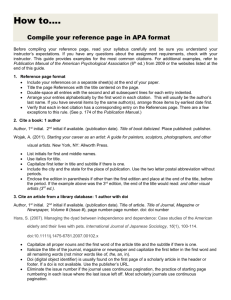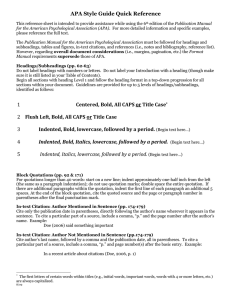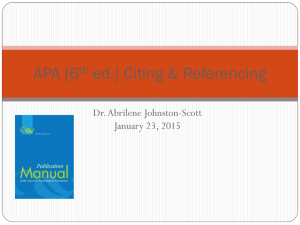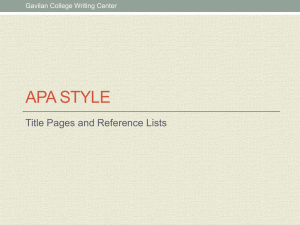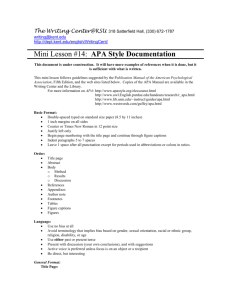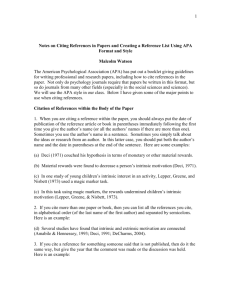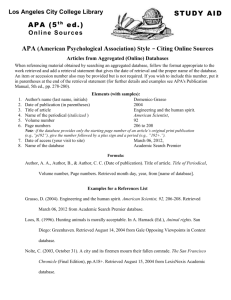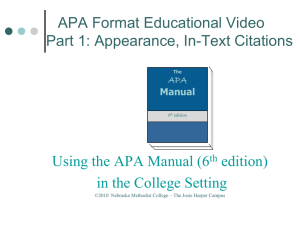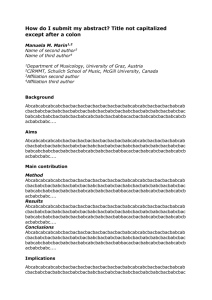APA Style References
advertisement
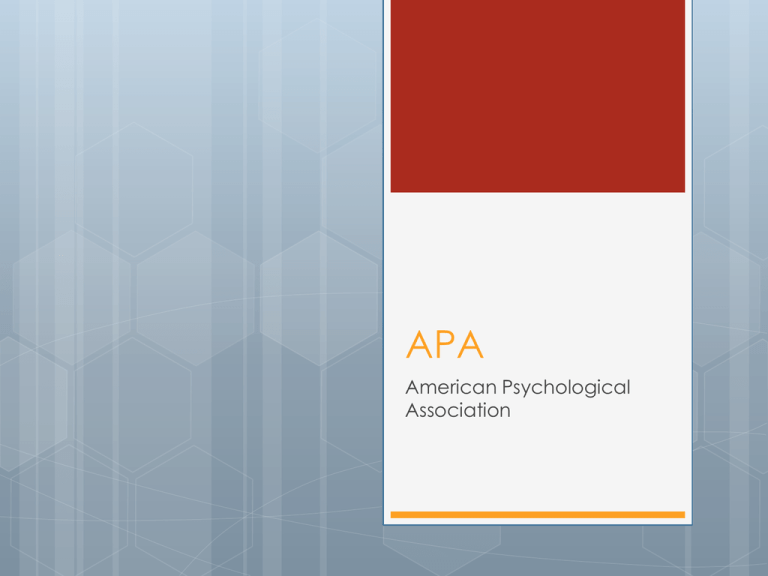
APA American Psychological Association What is APA? APA is the way that disciplines within the social sciences reference their citations. The social sciences include: Social Studies Anthropology Communication Studies Criminology Economics Education History Linguistics Law Political Science Psychology Social Psychology Social Work Why use APA? APA allows you to reference your citations when you quote, paraphrase, or use information that you found within a source such as a book, magazine, webpage, etc. What happens if you don’t reference your sources? You could be accused of PLAGIARISM Plagiarism happens when you advertently – or even inadvertently! – use someone else’s ideas and don’t say where you got them from. Plagiarism is not just “cutting & pasting” whole paragraphs or essays from a book or the web; it also happens when you put someone else’s ideas into your own words, but don’t give the author of those ideas credit for them. If in doubt, make a reference! What information do you need? There’s a lot of information you need to include in a reference: Author’s full name, including middle initial, if given Date of latest publication Title of the article, book, and/or journal in which the source is printed Publishing company Place of publication (include state or country if not readily recognizable) Page numbers, if your source is printed in a compilation or journal. What order do you put the information in? Ordering the information in a reference is the trickiest part of writing your bibliography. The order of the information and how you format it is really important. You want to provide the information in a clear manner that is standardized internationally so that anyone, anywhere can read your reference and find your source. Books – print: Deal, T. E. & Peterson, K. D. (2009). Shaping School Culture: Pitfalls, Paradoxes and Promises. San Francisco, CA: Jossey-Bass. Last name, first and middle initials (if given) of first author, followed by the ampersand sign (&) and the last name, first and middle initials of second author, etc. up to three authors. Date in parentheses. Title in italics. Place of publication: publication company. Textbook – print: Gardner, R., & Lavold, W. (2007). Exploring globalization, student text. Whitby, ON: McGraw-Hill Ryerson. Last name, first initial of first author listed, ampersand, Last name and first initial of second author listed. (Date of publication in parentheses). Title of Text book in italics, followed by student text. City and Province/State of publication: publishing company. Books – online: Deal, T. E. & Peterson, K. D. (2009). Shaping School Culture: Paradoxes, Pitfalls and Promises. Retrieved from http://www.jossey-bass.com Author’s last name, first name, middle initial. Ampersand followed by second author’s last name, first name, middle initial, etc. Date of publication or edition in parentheses. Title in italics. Retrieved from and include the website * note there is no period after the web address! Article or essay in a compilation: Deal, T.E & Peterson, K.D. (2009). “Toxic Cultures.” In J. Armstrong & F. Davis (Eds.), School Culture Handbook (238-301). New York, NY: Jossey-Bass. Author, A. A., & Author, B. B. (Year of publication). Title of chapter. In A. Editor & B. Editor (Eds.), Title of book (pages of chapter). Location: Publisher. Article in a journal – print: Deal, T.E. & Peterson, K.D. (2009). Renovating school culture. Education Today, 12(3), 21-33). Author, A. A., Author, B. B., & Author, C. C. (Year). Title of article. Title of Periodical, volume number(issue number), pages. * Note that the title of the article is not in quotation marks, and only the first word of the title is capitalized. Article in a journal – online: Deal, T.E. & Peterson, K.D. (2008). Working with school leaders. Leadership Today, 8(2). Retrieved from http://www.leadershiptoday.org Author, A. A., & Author, B. B. (Date of publication). Title of article. Title of Online Periodical, volume number(issue number if available). Retrieved from http://www.someaddress.com/full/url/ * Note that the title of the article is not in quotation marks, and only the first word of the title is capitalized. There is also no period after the website url. Online Article with a DOI* Brownlie, D. (2007). Toward effective poster presentations: An annotated bibliography. European Journal of Marketing, 41, 1245-1283. doi:10.1108/03090560710821161 Author, A. A., & Author, B. B. (Date of publication). Title of article. Title of Journal, volume number, page range. doi:0000000/000000000000 or http://dx.doi.org/10.0000/0000 * DOI stands for “Digital Object Identifier.” It’s a way of giving a unique number to every online text. It’s similar to an ISBN in a print text. Other sources… There are many other sources you will run across when you conduct your research, such as films, documentaries, newspaper articles, blogs, podcasts, etc. Make sure you consult an APA Style Guide to check you are referencing that source correctly. Style Guides: Publication Manual of the American Psychological Association. 6th Edition. http://owl.english.purdue.edu/owl/resour ce/560/01/ www.apastyle.org
